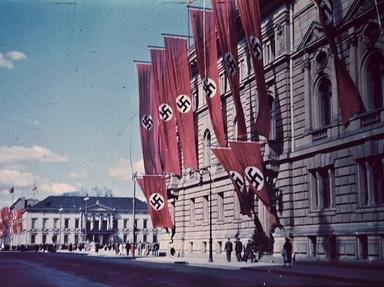Quiz Answer Key and Fun Facts
1. Pre-Nazi Berlin was a thriving city with desirable arts and culture venues as well as a popular nightlife scene. We now know, just as Gustav Stresemann knew, that despite good appearances, Weimar prosperity was built on unsustainable American loans. However, did the liberal Berlin society during the Weimar Republic tolerate gay people?
2. Hitler became Chancellor of Germany in January 1933 and he stamped on opposing views immediately. Hitler, taking advantage of the increasingly wide powers given to him by an ageing President Hindenburg and by the Reichstag, aimed to eradicate all opposition to his leadership and ideology, and one example of this was the burning of the books. Which Nazi paramilitary organisation was involved in overseeing this event which included burning gay literature?
3. The struggle for power in 1930s Germany was not just between the Nazis and other parties but also existed within the Nazi party itself. A certain man, who led a paramilitary organisation, was involved in a power struggle with Heinrich Himmler who would eventually head the department that had the responsibility for the concentration camps. Himmler would eventually emerge victorious after Adolf Hitler had his opponent assassinated in a purge. Hitler would later use the fact that this individual was homosexual as a justification for the killing. Who out of the following was purged in the Night of the Long Knives?
4. After the Night of the Long Knives the anti-homosexual sentiments expressed by the Nazi party stepped up a gear. Heinrich Himmler, one of the top Nazi officials, established a department which was named the, 'Reich Central Office for the Combating of Homosexuality and ___'. What word fills the blank and completes the department's name?
(Clue: think population!)
5. "Vernichtung durch Arbeit" is the German phrase for a policy adopted by concentration camp officials, a policy of pushing inmates to the point of destruction. What is the translation of this phrase (which describes how many Jews, homosexuals and others were treated in the camps) into English?
6. By the end of the twentieth century only a small number of gay men had told the public of their struggle in the concentration and work camps. Perhaps the best known of these was a Frenchman (died in 2005) who is remembered for his book, 'Moi, ___, déporté homosexuel'. Who is this Frenchman whose name also fills the blank?
7. Gay men were just one of a vast number of groups that were deemed "undesirable" by the Nazi German authorities. If a gay man was detained in a concentration camp he would be assigned a triangle of a certain colour. What colour would the triangle be?
8. Within the horrendous surrounds of the Nazi concentration camp system lesbians were incarcerated, but they were not imprisoned under anti-homosexual legislation. Lesbians in Nazi Germany were allegedly deemed to be "anti-social" and as such it is now believed by some that they had to wear a triangle badge of which colour?
9. According to a variety of sources, including the academic work of sociologist Rüdiger Lautmann, gay people imprisoned in the concentration camps had a significantly higher death rate than any other classification of inmate (except Jews).
Gay concentration camp inmates suffered abuse and maltreatment from other prisoners.
10. One of the most notorious of all the concentration camps was the Polish based Auschwitz group of camps, which was liberated by Soviet troops on January 27, 1945. Many gay prisoners perished during the camp's active years but it wasn't until the late 1970s to early 1980s that the 'gay story' was starting to be told. Many world cities erected monuments specifically for the gay people who suffered in the Holocaust and one such monument is in the capital of Uruguay. Where is this monument?
Source: Author
jonnowales
This quiz was reviewed by FunTrivia editor
bloomsby before going online.
Any errors found in FunTrivia content are routinely corrected through our feedback system.

